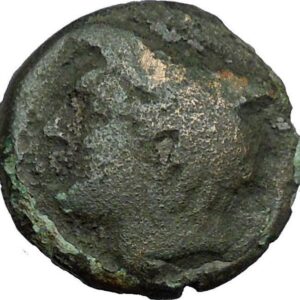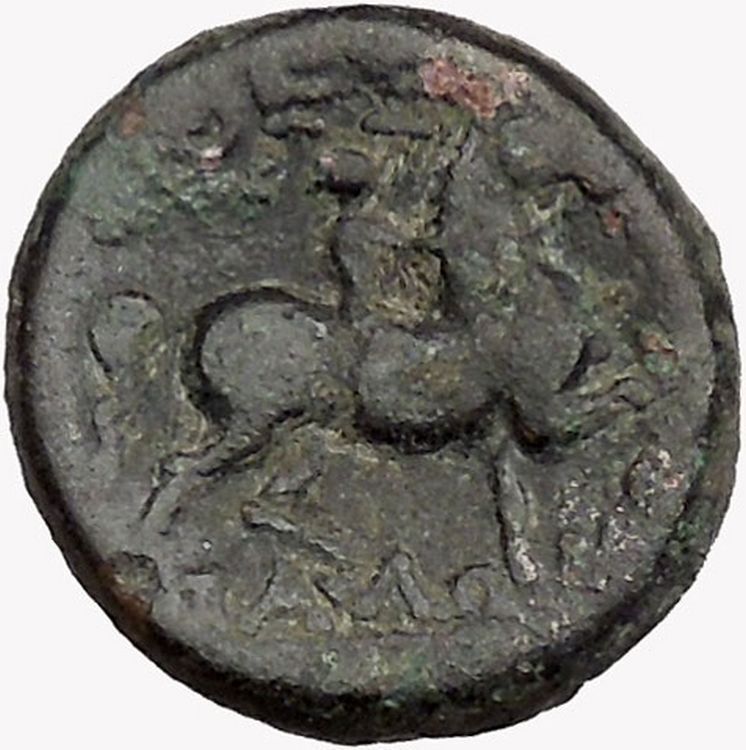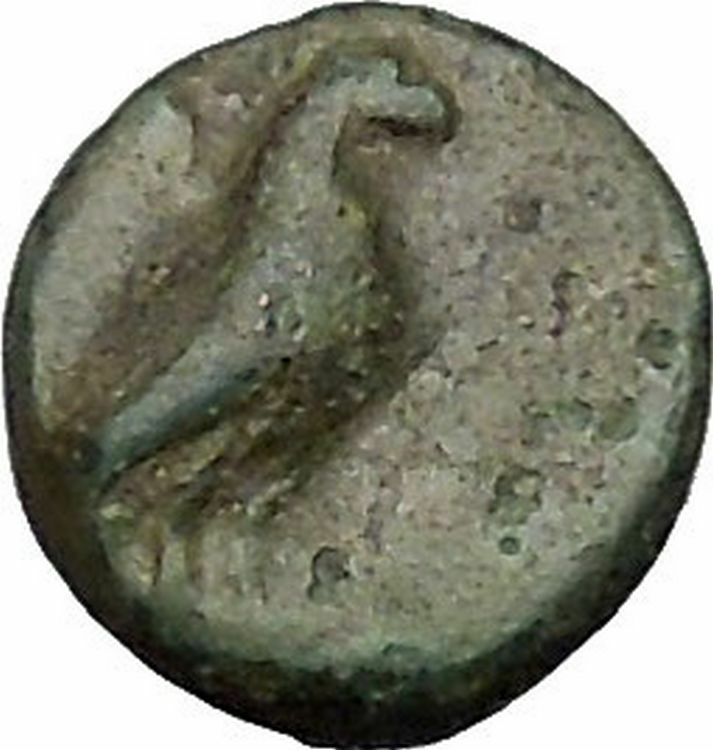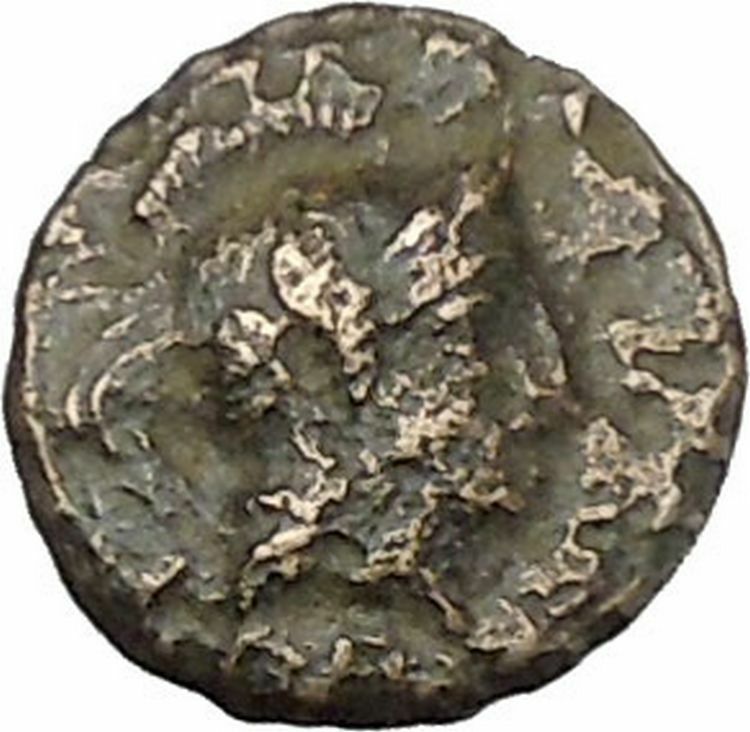|
Greek city of <font ioniaSelinos in Sicily
Bronze 15mm (3.89 grams) Struck circa 450-440 B.C.
Reference: HGC 2, 1236 Rare R1
Anepigraphic. Facing head of Silenus.
Celery leaf.
One of the most important towns in Sicily, situated upon a hill on the S.W. coast, and upon a river of the same name. It was founded by Dorians from Megara Hyblaea on the E. coast of Sicily, B.C. 628. It soon attained great prosperity ; but it was taken by the Carthaginians in 409 B.C., when the greater part of the city destroyed. After the Carthaginians allowed inhabitants return to the town in the same year, it became a place of secondary importance until 249 B.C., when it was again destroyed by the Carthaginians and it’s inhabitants transferred to Lilybaeum. The surrounding country produced excellent wheat. East of Selinos on the road to Agrigentum, were celebrated mineral springs called Aquae Selinuntiae, subsequently Aquae Labodae or Labodes, the modern Baths of Sciocca. There are still considerable ruins of Selinos.
You are bidding on the exact item pictured, provided with a Certificate of Authenticity and Lifetime Guarantee of Authenticity.
.JPG/220px-Sileno_(Museo_del_Louvre).JPG) In Greek mythology, Silenus was a companion and tutor to the wine god Dionysus. He is typically older than the satyrs of the Dionysian retinue (thiasos), and sometimes considerably older, in which case he may be referred to as a Papposilenus. The plural sileni refers to the mythological figure as a type that is sometimes thought to be differentiated from a satyr by having the attributes of a horse rather than a goat, though usage of the two words is not consistent enough to permit a sharp distinction. In Greek mythology, Silenus was a companion and tutor to the wine god Dionysus. He is typically older than the satyrs of the Dionysian retinue (thiasos), and sometimes considerably older, in which case he may be referred to as a Papposilenus. The plural sileni refers to the mythological figure as a type that is sometimes thought to be differentiated from a satyr by having the attributes of a horse rather than a goat, though usage of the two words is not consistent enough to permit a sharp distinction.
Evolution of the character
The original Silenus resembled a folkloric man of the forest with the ears of a horse and sometimes also the tail and legs of a horse. The later sileni were drunken followers of Dionysus, usually bald and fat with thick lips and squat noses, and having the legs of a human. Later still, the plural “sileni” went out of use and the only references were to one individual named Silenus, the teacher and faithful companion of the wine-god Dionysus.
A notorious consumer of wine, he was usually drunk and had to be supported by satyrs or carried by a donkey. Silenus was described as the oldest, wisest and most drunken of the followers of Dionysus, and was said in Orphic hymns to be the young god’s tutor. This puts him in a company of phallic or half-animal tutors of the gods, a group that include Priapus, Hermaphroditus, Cedalion and Chiron, but also includes Pallas, the tutor of Athena.
When intoxicated, Silenus was said to possess special knowledge and the power of prophecy. The Phrygian King Midas was eager to learn from Silenus and caught the old man by lacing a fountain from which Silenus often drank. As Silenus fell asleep, the king’s servants seized and took him to their master. Silenus shared with the king a pessimistic philosophy: That the best thing for a man is not to be born, and if already born, to die as soon as possible. An alternative story was that when lost and wandering in Phrygia, Silenus was rescued by peasants and taken to King Midas, who treated him kindly. In return for Midas’ hospitality Silenus told him some tales and Midas, enchanted by Silenus’s fictions, entertained him for five days and nights. Dionysus offered Midas a reward for his kindness towards Silenus, and Midas chose the power of turning everything he touched into gold. Another story was that Silenus had been captured by two shepherds, and regaled them with wondrous tales.
In Euripides’s satyr play Cyclops, Silenus is stranded with the satyrs in Sicily, where they have been enslaved by the Cyclops. They are the comic elements of the story, a parody of Homer’s Odyssey IX. Silenus refers to the satyrs as his children during the play.
Silenus may have become a Latin term of abuse around 211 BC, when it is used in Plautus’ Rudens to describe Labrax, a treacherous pimp or leno, as “…a pot-bellied old Silenus, bald head, beefy, bushy eyebrows, scowling, twister, god-forsaken criminal”. In his satire The Caesars, the emperor Julian has Silenus sitting next to the gods to offer up his comments on the various rulers under examination, including Alexander the Great, Julius Caesar, Augustus, Marcus Aurelius (whom he reveres as a fellow philosopher-king), and Constantine I.
Silenus commonly figures in Roman bas-reliefs of the train of Dionysus, a subject for sarcophagi, embodying the transcendent promises of Dionysian cult.
Selinunte (Greek: Σελινοῦς; Latin: Selinus) is an ancient Greek archaeological site on the south coast of Sicily, southern Italy, between the valleys of the rivers Belice and Modione in the province of Trapani. The archaeological site contains five temples centered on an acropolis. Of the five temples, only the Temple of Hera, also known as “Temple E”, has been re-erected.
History
Selinunte was one of the most important of the Greek colonies in Sicily, situated on the southwest coast of that island, at the mouth of the small river of the same name, and 6.5 km west of that of the Hypsas (the modern Belice River). It was founded, according to historian Thucydides, by a colony from the Sicilian city of Megara, or Megara Hyblaea, under the conduct of a leader named Pammilus, about 100 years after the settlement of that city, with the addition of a fresh body of colonists from the parent city of Megara in Greece. The date of its foundation cannot be precisely fixed, as Thucydides indicates it only by reference to that of the Sicilian Megara, which is itself not accurately known, but it may be placed about 628 BCE. Diodorus places it 22 years earlier, or 650 BCE, and Hieronymus still further back, 654 BCE. The date from Thucydides, which is probably the most likely, is incompatible with this earlier epoch. The name is supposed to have been derived from quantities of wild parsley (Greek: σέλινον-selinon) that grew on the spot. For the same reason, they adopted the parsley leaf as the symbol on their coins.
Selinunte was the most westerly of the Greek colonies in Sicily, and for this reason was early brought into contact and collision with the Carthaginians and the native Sicilians in the west and northwest of the island. The former people, however, do not at first seem to have offered any obstacle to their progress; but as early as 580 BCE we find the Selinuntines engaged in hostilities with the people of Segesta (a non-Hellenic city), whose territory bordered on their own. The arrival of a body of emigrants from Rhodes and Cnidus who subsequently founded Lipara, and who lent their assistance to the Segestans, for a time secured the victory to that people; but disputes and hostilities seem to have been of frequent occurrence between the two cities, and it is probable that in 454 BCE, when Diodorus speaks of the Segestans as being at war with the Lilybaeans (modern Marsala), that the Selinuntines are the people really meant. The river Mazarus, which at that time appears to have formed the boundary between the two states, was only about 25 km west of Selinunte; and it is certain that at a somewhat later period the territory of Selinunte extended to its banks, and that that city had a fort and emporium at its mouth On the other side its territory certainly extended as far as the Halycus (modern Platani), at the mouth of which it founded the colony of Minoa, or Heracleia, as it was afterward termed It is evident, therefore, that Selinunte had early attained to great power and prosperity; but we have very little information as to its history. We learn, however, that, like most of the Sicilian cities, it had passed from an oligarchy to a despotism, and about 510 BCE was subject to a despot named Peithagoras, from whom the citizens were freed by the assistance of the Spartan Euryleon, one of the companions of Dorieus: and thereupon Euryleon himself, for a short time, seized on the vacant sovereignty, but was speedily overthrown and put to death by the Selinuntines. The causes leading the Selinuntines to abandon the cause of the other Greeks, and take part with the Carthaginians during the great expedition of Hamilcar (480 BCE) are unknown; they had even promised to send a contingent to the Carthaginian army, which, however did not arrive till after its defeat
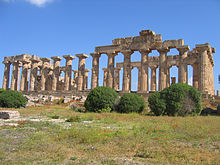
“Temple E”
The Selinuntines are next mentioned in 466 BCE, as co-operating with the other free cities of Sicily in assisting the Syracusans to expel Thrasybulus; and there is every reason to suppose that they fully shared in the prosperity of the half century that followed, a period of tranquility and opulence for most of the Greek cities in Sicily. Thucydides speaks of Selinunte just before the Athenian expedition as a powerful and wealthy city, possessing great resources for war both by land and sea, and having large stores of wealth accumulated in its temples. Diodorus also represents it at the time of the Carthaginian invasion, as having enjoyed a long period of tranquility, and possessing a numerous population.
In 416 BCE, a renewal of the old disputes between Selinunte and Segesta became the occasion of the great Athenian expedition to Sicily. The Selinuntines were the first to call in the powerful aid of Syracuse, and thus for a time obtained the complete advantage over their enemies, whom they were able to blockade both by sea and land; but in this extremity the Segestans had recourse to the assistance of Athens. Though the Athenians do not appear to have taken any measures for the immediate relief of Segesta, it is probable that the Selinuntines and Syracusans withdrew their forces at once, as we hear no more of their operations against Segesta. Nor does Selinunte bear any important part in the war of which it was the immediate occasion. Nicias indeed proposed, when the expedition first arrived in Sicily (415 BCE); that they should proceed at once to Selinunte and compel that city to submit on moderate terms; but this advice being overruled, the efforts of the armament were directed against Syracuse, and the Selinuntines in consequence bore but a secondary part in the subsequent operations. They are, however, mentioned on several occasions as furnishing auxiliaries to the Syracusans; and it was at Selinunte that the large Peloponnesian force sent to the support of Gylippus landed in the spring of 413 BCE, having been driven over to the coast of Africa by a tempest.
The defeat of the Athenian armament apparently left the Segestans at the mercy of their rivals. They tried in vain to ease Selinuntine hostility by ceding without further contest the frontier district that was the original subject of dispute. The Selinuntines, however, were not satisfied with this concession, and continued to press them with fresh aggressions, leading the Segestans to seek assistance from Carthage. After some hesitation, Carthage sent a small force, with the assistance of which the Segestans defeated the Selinuntines in a battle. The Carthaginians in the following spring (409 BCE) sent over a vast army amounting, according to the lowest estimate, to 100,000 men, with which Hannibal Mago (the grandson of Hamilcar that was killed at Himera) landed at Lilybaeum, and from thence marched direct to Selinunte. The city’s inhabitants had not expected such a force and were wholly unprepared to resist it. The city fortifications were, in many places, in disrepair, and the auxiliary force promised by Syracuse and Agrigentum (modern Agrigento) and Gela, was not ready and did not arrive in time. The Selinuntines defended themselves with the courage of despair, and even after the walls were breached, continued the contest from house to house. However, the enemy’s overwhelming numbers rendered resistance hopeless, and after a ten-day siege the city was taken and most of the defenders put to the sword. According to sources, of the citizens of Selinunte 16,000 were slain, 5,000 made prisoners, and 2,600 under the command of Empedion escaped to Agrigentum. Shortly after, Hannibal destroyed the city walls, but gave permission to the surviving inhabitants to return and occupy it as tributaries of Carthage, an arrangement confirmed by the treaty subsequently concluded between Dionysius, tyrant of Syracuse, and the Carthaginians, in 405 BCE. In the interval a considerable number of the survivors and fugitives had been brought together by Hermocrates, and established within its walls. A considerable part of the citizens of Selinunte availed themselves of this permission, and that the city continued to subsist under the Carthaginian dominion; but a fatal blow had been given to its prosperity, which it undoubtedly never recovered.
The Selinuntines are again mentioned in 397 BCE as declaring in favor of Dionysius during his war with Carthage; but both the city and territory were again given up to the Carthaginians by the peace of 383 BCE (Id. xv. 17); and though Dionysius recovered possession of it by arms shortly before his death, it is probable that it soon again lapsed under the dominion of Carthage. The Halycus, which was established as the eastern boundary of the Carthaginian dominion in Sicily by the treaty of 383 BCE, seems to have generally continued to be so recognized, notwithstanding temporary interruptions; and was again fixed as their limit by the treaty with Agathocles in 314 BCE. This last treaty expressly stipulated that Selinunte, as well as Heracleia and Himera, should continue subject to Carthage, as before. In 276 BCE, however, during the expedition of Pyrrhus to Sicily, the Selinuntines voluntarily submitted to that monarch, after the capture of Heracleia. During the First Punic War we again find Selinunte subject to Carthage, and its territory was repeatedly the theater of military operations between the contending powers. But before the close of the war (about 250 BCE), when the Carthaginians were beginning to contract their operations, and confine themselves to the defense of as few points as possible, they removed all the inhabitants of Selinunte to Lilybaeum and destroyed the city
It seems certain that it was never rebuilt. Pliny the Elder indeed, mentions its name (Selinus oppidum), as if it still existed as a town in his time, but Strabo distinctly classes it with extinct cities. Ptolemy, though he mentions the river Selinus, has no notice of a town of the name. The Thermae Selinuntiae (at modern Sciacca), which derived their name from the ancient city, and seem to have been much frequented in the time of the Romans, were situated at a considerable distance, 30 km, from Selinunte: they are sulfurous springs, still much valued for their medical properties, and dedicated, like most thermal waters in Sicily, to San Calogero. At a later period they were called the Aquae Labodes or Larodes, under which name they appear in the Itineraries.
Modern situation and ruins

Ground floor of Temple A (ca. 480 BC). The remains of the two spiral stairs between the pronaos and the cella are the oldest known to date (see List of ancient spiral stairs).
By the 19th century, the site of the ancient city was wholly desolate, with the exception of a solitary guardhouse, and the ground for the most part thickly overgrown with shrubs and low brushwood; but the remains of the walls could be distinctly traced throughout a great part of their circuit. They occupied the summit of a low hill, directly abutting on the sea, and bounded on the west by the marshy valley through which flows the river Madiuni, the ancient Selinus; on the east by a smaller valley or depression, also traversed by a small marshy stream, which separates it from a hill of similar character, where the remains of the principal temples are still visible. The space enclosed by the existing walls is of small extent, so that it is probable the city in the days of its greatness must have covered a considerable area without them: and it has been supposed by some writers that the present line of walls is that erected by Hermocrates when he restored the city after its destruction by the Carthaginians. No trace is, however, found of a more extensive circuit, though the remains of two lines of wall, evidently connected with the port, are found in the small valley east of the city. Within the area surrounded by the walls are the remains of three temples, all of the Doric order, and of an ancient style; none of them were standing until the temple designated “Temple E” was re-erected in the 20th century, but the foundations of them all remain, together with numerous portions of columns and other architectural fragments, sufficient to enable one to restore the plan and design of all three without difficulty. The largest of them is 70 m long by 25 m broad, and has 6 columns in front and 18 in length, a very unusual proportion. All these are hexastyle and peripteral. Besides these three temples there is a small temple or Aedicula, of a different plan, but also of the Doric order. No other remains of buildings, beyond mere fragments and foundations, can be traced within the walls; but the outlines of two large edifices, built of squared stones and in a massive style, are distinctly traceable outside the walls, near the northeast and northwest angles of the city, though their nature or purpose is unclear.
But much the most remarkable of the ruins at Selinus are those of three temples on the hill to the east, which do not appear to have been included in the city, but, as was often the case, were built on this neighboring eminence, so as to front the city itself. All these temples are considerably larger than any of the three above described; and the most northerly of them is one of the largest of which we have any remains. It had 8 columns in front and 17 in the sides, and was of the kind called pseudo-dipteral. Its length was 110 m, and its breadth 55 m, so that it was actually longer than the great Temple of Olympian Zeus at Agrigentum, though not equal to it in breadth. From the columns being only partially fluted, as well as from other signs, it is clear that it never was completed; but all the more important parts of the structure were finished, and it must have certainly been one of the most imposing fabrics in antiquity. Only three of the columns are now standing, and these imperfect; but the whole area is filled up with a heap of fallen masses, portions of columns, capitals, and other huge architectural fragments, all of the most massive character, and forming, as observed by Henry Swinburne, one of the most gigantic and sublime ruins imaginable. The two other temples are also prostrate, but the ruins have fallen with such regularity that the portions of almost every column lie on the ground as they have fallen; and it is not only easy to restore the plan and design of the two edifices, but it appears as if they could be rebuilt with little difficulty.
The southernmost of the three temples, the Temple of Hera, also known as “Temple E,” was reconstructed in the 20th century, as may be seen in the photographs below. A 1st century BC Greek inscription on the building records its dedication to Hera.
These temples, though greatly inferior to their gigantic neighbor, were still larger than that at Segesta, and even exceed the great temple of Neptune at Paestum; so that the three, when standing, must have presented a spectacle unrivaled in antiquity. All these buildings may be safely referred to a period anterior to the Carthaginian conquest (409 BCE), though the three temples last described appear to have been all of them of later date than those within the walls of the city. This is proved, among other circumstances, by the sculptured metopes, several of which have been discovered and extricated from among the fallen fragments. Those of these sculptures that belonged to the temples within the walls, present a peculiar and archaic style of art, and are universally recognized as among the earliest extant specimens of Greek sculpture Those, on the contrary, which have been found among the ruins of the temple on the opposite hill, are of a later and more advanced style, though still retaining considerable remains of the stiffness of the earliest art. Besides the interest attached to these Selinuntine metopes from their important bearing on the history of Greek sculpture, the remains of these temples are of value as affording the most unequivocal testimony to the use of painting, both for the architectural decoration of the temples, and as applied to the sculptures with which they were adorned.
Coinage
The coins of Selinus are numerous and various. The earliest, as already mentioned, bear merely the figure of a parsley-leaf on the obverse. Those of somewhat later date represent a figure sacrificing on an altar, which is consecrated to Aesculapius, as indicated by a cock that stands below it. The subject of this type evidently refers to a story related by Diogenes Laertius that the Selinuntines were afflicted with a pestilence from the marshy character of the lands adjoining the neighboring river, but that this was cured by works of drainage, suggested by Empedocles. A figure standing on some coins is the river-god Selinus, who was thus made conducive to the salubrity of the city.
|





.JPG/220px-Sileno_(Museo_del_Louvre).JPG) In Greek mythology, Silenus was a companion and tutor to the wine god Dionysus. He is typically older than the satyrs of the Dionysian retinue (thiasos), and sometimes considerably older, in which case he may be referred to as a Papposilenus. The plural sileni refers to the mythological figure as a type that is sometimes thought to be differentiated from a satyr by having the attributes of a horse rather than a goat, though usage of the two words is not consistent enough to permit a sharp distinction.
In Greek mythology, Silenus was a companion and tutor to the wine god Dionysus. He is typically older than the satyrs of the Dionysian retinue (thiasos), and sometimes considerably older, in which case he may be referred to as a Papposilenus. The plural sileni refers to the mythological figure as a type that is sometimes thought to be differentiated from a satyr by having the attributes of a horse rather than a goat, though usage of the two words is not consistent enough to permit a sharp distinction.



